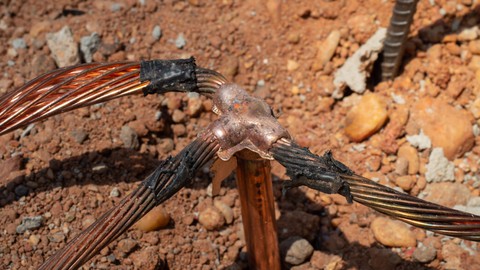
Published 08/2022
MP4 | Video: h264, 1280x720 | Audio: AAC, 44.1 KHz, 2 Ch
Genre: eLearning | Language: English + srt | Duration: 34 lectures (4h 47m) | Size: 3.52 GB
Learn from Professionals, Electrical Power Engineering
What you'll learn
Understand need of earthing or grounding
What is it mean by earthing, what need to be earthed
Identify earthing during visual inspection of substation
Advantage of earthing
Maintenance earthing
Earthing for human and equipment safety, mechanical forces during sub-transient
Characteristics of good earthing
Difference between earthing and bonding
What is Bonding and why it is different from Earthing
Soil Characteristics, Sphere of influence, Earth Rod, Resistivity
Earthing design concept
Base design of earthing, material use for earthing
How make joints in earthing, exothermic welding
Over View of Earthing System
Voltage Gradient and Ground Potential Rise
Ground Potential Rise
Step and touch Voltage
Transfer Potential , Soil Resistivity
How to Measure Soil Resistivity
Earthing Grid Conductor Sizing
Step and Potential limits
Surface Layer Material and why gravel is used
Maximum Grid Current
Earthing Compound, types, test and benefits
Requirements
Eager to learn
Description
Earthing & Grounding
Earthing System or Grounding System in an electrical network work as a safety measure to protect human life as well as equipment, the main objective of the Earthing system is to provide an alternative path for dangerous currents to flow so that accidents due to electric shock and damage to the equipment can be avoided.
1. Going through concept of Grounding Vs Earthing
2. What is it mean by Earthing, what need to be earthed
3. Visual inspection of distribution transformer and identifying the earth connection points in a substation
4. Visual Inspection of Generator and Identifying Grounding
5. Visual Inspection of Gas Insulated Substation and Identifying Earthing
6. Why to Earth or Ground, Advantages of Earthing
7. Maintenance Earthing
8. Earthing for Human and equipment safety, Mechanical forces during sub-transient
9. Definition of Earthing and basic concept
10. Objective of Earthing System
11. Good Earthing Characteristics, Low Impedance
12. Good Earthing System, Standard Earth Resistance Value
13. Good Earthing System, Corrosion Resistant, Mechanical strength
14. Static Charge Grounding
15. Good Earthing and Ground Potential Rise
16. Earthing and lighting protection
17. What Need to Earth
18. What is Bonding and why it is different from Earthing
19. Soil Characteristics, Sphere of influence, Earth Rod, Resistivity
20. Earthing Design Concept
21. Earthing Material and Earthing Base Design
22. How make joints in Earthing, Exothermic Welding
23. Over View of Earthing System
24. Voltage Gradient and Ground Potential Rise
25. Ground Potential Rise
26. Step and touch Voltage
27. Transfer Potential
28. Soil Resistivity
29. How to Measure Soil Resistivity
30. Earthing Grid Conductor Sizing
31. Step and Potential limits
32. Surface Layer Material and why gravel is used
33. Maximum Grid Current
34. Earthing Compound
Best Regards
Who this course is for
technicians, engineers, students

Download From Rapidgator
https://rapidgator.net/file/6fe7b9d0b3a6d83de46f0d78766eca01
https://rapidgator.net/file/0d43a55bac9f5fd4b644136b6e2367d8
https://rapidgator.net/file/09fe121b5a83f6759cb284da07969b5c
https://rapidgator.net/file/952ceb50784d7695f0d6690a7855809c
Download From 1DL
https://1dl.net/grud6n9ui583
https://1dl.net/wwi2bi7xow3w
https://1dl.net/cc1fh606wfo4
https://1dl.net/7x9jnv2s7s8o
To Support My Work Buy Premium From My Links.










